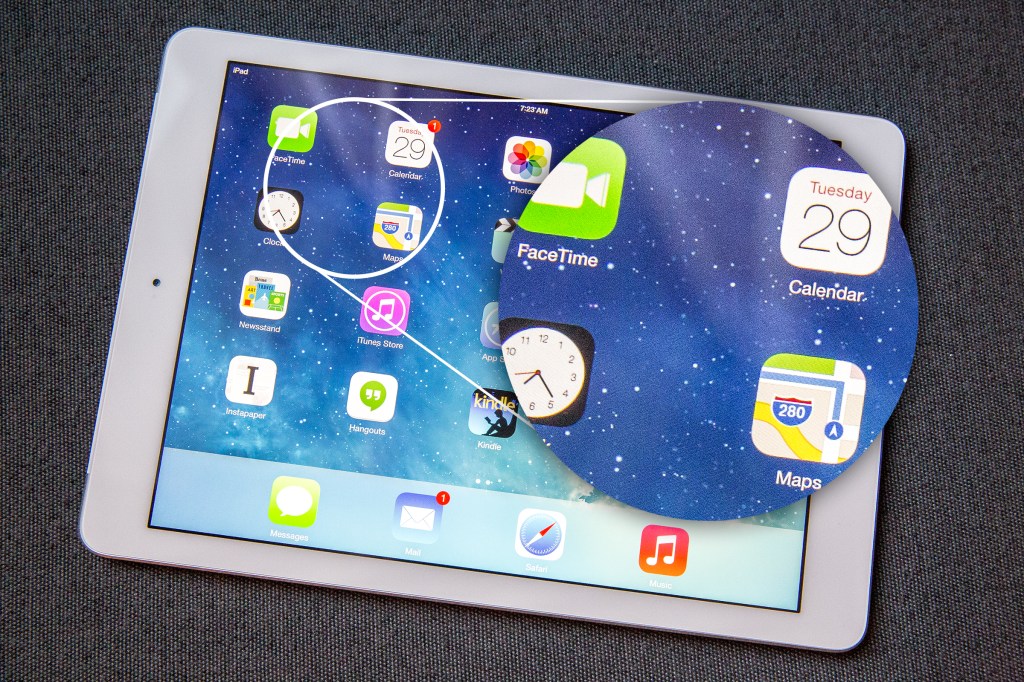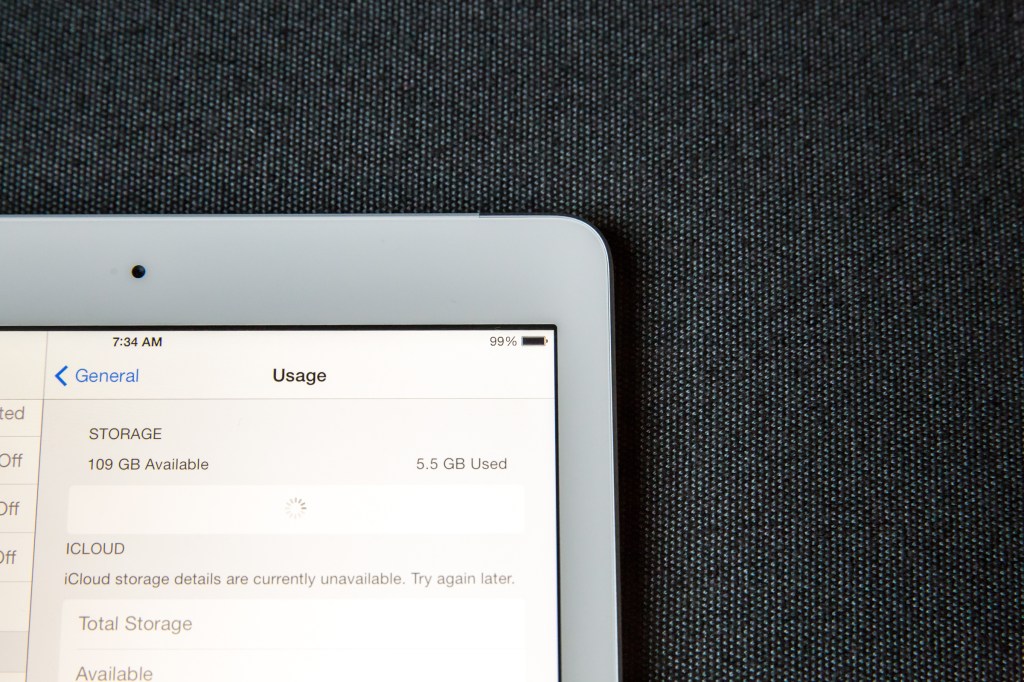Apple Replacing ‘Limited’ Number Of iPhone 5s With Manufacturing Issue Leading To Battery Life Problem
Apple introduced two new iPads this month at a special event in San Francisco on October 22, and the first of those to go on sale is the iPad Air, which is in stores and on virtual shelves this Friday, November 1. After a week with Apple’s newest 9.7-inch device, it’s clear there’s a new champion of the large tablet market, and one that breathes new life into Apple’s original slab-style game-changer.
Video Review
Basics
- 2048 x 1536 (Retina) 9.7-inch display
- 16GB, 32GB, 64GB and 128GB
- A7 processor
- 802.11n dual-channel Wi-Fi, Bluetooth 4.0
- 10 hours general use Wi-Fi surfing, 9 hours on cellular
- Starts at $499
Pros
- Thin and light design is a huge improvement over 4th-gen iPad
- No battery life sacrifices required
Cons
- Hard sell over the iPad mini with Retina, which also now has A7 power
Design
The design is the star of Apple’s iPad Air refresh this time around; the 9.7-inch Apple tablet has had the same form factor for two generations now, and that one actually made the design worse – it got heavier, and it got thicker. This new iPad mini-inspired look sheds both size and weight, giving the iPad Air a 43 percent smaller bezel, a 20 percent thinner case, and making it 28 percent lighter, at just one pound.
It’s a difference that you feel, all numbers and measurements aside. The iPad Air is much, much more comfortable to hold than the iPad 4th-gen it replaces; This isn’t strictly a one-handed device, but it’s as close as you can get with a tablet that still has a gorgeous, expansive 9.7-inch Retina Display.
The aesthetics of the iPad Air are also improved: That smaller bezel better showcases the screen, for instance, and the mirror finish Apple logo is a nice touch. The silver version I reviewed is very nice, though I personally prefer the space gray finish in this device based on comparing them both at the Apple event itself. Plus, the speaker design is improved both in terms of looks and sound quality.
Display

The screen on the iPad Air is a Retina display, which means that when viewed from a standard distance, the human eye shouldn’t be able to make out individual pixels. The actual pixel density of that 2048 x 1536 9.7-inch display is 264 PPI, which is much less dense than the iPad mini, but you’d have a hard time telling the difference when you’re actually using the thing. In short, both are excellent, and lead the market in terms of quality when you factor in color rendering, viewing angle and other visual attributes.
Having used primarily an iPad mini for the past year, there’s no question that coming back to the 9.7-inch Retina display was an uplifting experience. It felt a little like getting your prescription adjusted and realizing you’ve been seeing everything poorly for a long time. Video shines on the iPad Air, as does image-rich content like comic books and photos.
There’s no question that coming back to the 9.7-inch Retina display was an uplifting experience.
Not to mention that all that extra space makes for a much more comfortable browsing experience, and offers a lot of benefits when it comes to content creation. It doesn’t feel arduous doing work on the iPad; you can start to remember why people touted the iPad as a PC-killer when it debuted, and it edges ever closer to being able to truly replace notebooks for the majority of everyday users.
Related Videos
Features
Apple’s iPad Air has some new powers compared to its predecessor – chief among those is the new A7 64-bit processor, and the M7 motion coprocessor that goes along with that. This means that like its cousin the iPhone 5s, it’s a “forward thinking” device, but it also brings benefits right away, thanks in large part to Apple’s own redesigned first-party apps.
 When using the new iLife and iWork suites, performance is considerably bolstered by the 64-bit retrofits they got with their recent redesigns – everything feels faster and more responsive. 64-bit processing doesn’t mean that every app necessarily gets a 2x boost in performance over those made for the traditional 32-bit architecture used in previous iPads, but it does mean that software made for those processors will feel even more instantly responsive than it has in the past.
When using the new iLife and iWork suites, performance is considerably bolstered by the 64-bit retrofits they got with their recent redesigns – everything feels faster and more responsive. 64-bit processing doesn’t mean that every app necessarily gets a 2x boost in performance over those made for the traditional 32-bit architecture used in previous iPads, but it does mean that software made for those processors will feel even more instantly responsive than it has in the past.
Also new to the iPad Air are dual microphones which help out with sound quality on audio and video FaceTime calls, and the motion coprocessor means that you’ll start to see more activity tracking built into the iPad, too. It may seem an odd feature for a tablet, but the iPad is designed to go with you where you go, and it might be even more representative of your general activity level since it won’t be triggered so easily as a phone worn close to the body.
Cameras also get an update with the iPad Air, which is to be expected. The real gem here is the FaceTime HD camera that offers 1080p video calling instead of 720p on the last model, which does make a difference. It also has a new 5-megapixel shooter that gets bigger pixels on the sensor, which does lead to better photos. I feel no less ridiculous taking photos with a 9.7-inch tablet than I did before, however, but if that’s the type of photography you go in for, you’ll be better served with this device.
Performance
The iPad Air may be a lightweight device physically, but it’s a heavyweight when it comes to performance. Benchmarks tell only one side of the story, and the one that most users will be more interested in is around how the tablet work under normal, everyday usage conditions. Put simply, Apple’s latest iPad soars.
Put simply, Apple’s latest iPad soars.
Other performance tweaks from the A7 include support for OpenGL ES version 3.0 graphics, which makes it possible to build effects into games that were previously only available on the desktop. This iPad is a really strong gaming advice I learned based on my testing with Batman: Arkham Origins on the tablet, and you really get the sense that developers are just cracking the surface when it comes to what they can do with these new graphics capabilities.
The version I tested also supports LTE, and this iPad supports the most frequencies of that network technology than ever before. I was able to test out those claims right away, thanks to taking the device from San Francisco out to London. The iPad Air worked perfectly on both AT&T and on EE LTE, making this a world traveler’s best friend and constant companion. Thanks to FaceTime Audio and third-party apps like Skype, this could easily operate as someone’s international travel phone, letting people escape costly roaming charges.
Battery

The iPad Air’s battery offers up to 10 hours of continuous usage, according to Apple’s official published specs, and I’ve found that it easily matches up with the high bar set for power by previous generations. On average, I found myself getting around 10 hours of actual use on Wi-Fi, and slightly less on LTE networks. Standby time seems to have improved considerably with this generation, also, as the iPad Air seemed to positively sip battery life while unplugged but with the screen asleep.
Part of the iPad’s magic is the fact that you can put it down and forget about it for days, then pick it up and still have nearly a full charge. That’s still the case, and it’s made all the more impressive based on the physical changes Apple has made to the case design, which theoretically should leave less room inside for actual batteries.
Cases
Apple has two cases for the iPad Air, and they follow in the footsteps of those that came before. There’s the Smart Cover, and the Smart Case, both of which feature a magnetic closure with a multi-panelled front. The Case, as its name implies, also has a back component, but the Cover just protects the screen.
The Smart Case comes in leather variants, while the Cover is only offered in polycarbonate materials now, though both are offered in multiple color schemes. In almost every single instance where an Apple device is involved, I’m a fan of not using a case at all; the bumps and scratches that inevitably ensue help give the great design character, in my opinion. But if you’re going to get a case, I’d opt for the Smart Cover, as it adds virtually no bulk and protects the part of the iPad that is most important to protect – the glass.
The Smart Case makes the iPad Air feel quite a bit more bulky, in my opinion, and is fairly difficult to get off once its on. On the other hand, it’s definitely more protective than the Smart Case, and it’s still relatively svelte. Apple has also nailed its leather case designs in terms of putting out a product that feels very high quality, and that’s what they’ve done here, too.
Bottom Line
The iPad Air is a huge improvement over the iPad 4th-gen, or the iPad 2, pictured in the gallery. Its form factor is the best currently available for a 10-inch tablet, and it provides a great blend of portability and usability that leans towards the media device end of the spectrum.
When Apple introduced the iPad mini, I feel in love and felt that I’d never be swayed back to the other side. The iPad Air makes the argument anew that there’s still room for big tablets in people’s lives, and it might just help usher in an era of computing where households own more than one kind of iPad, and PCs are harder and harder to find.
Category: When Was The First Parachute Jump? brandon marshall harry potter
No comments:
Post a Comment
Note: Only a member of this blog may post a comment.